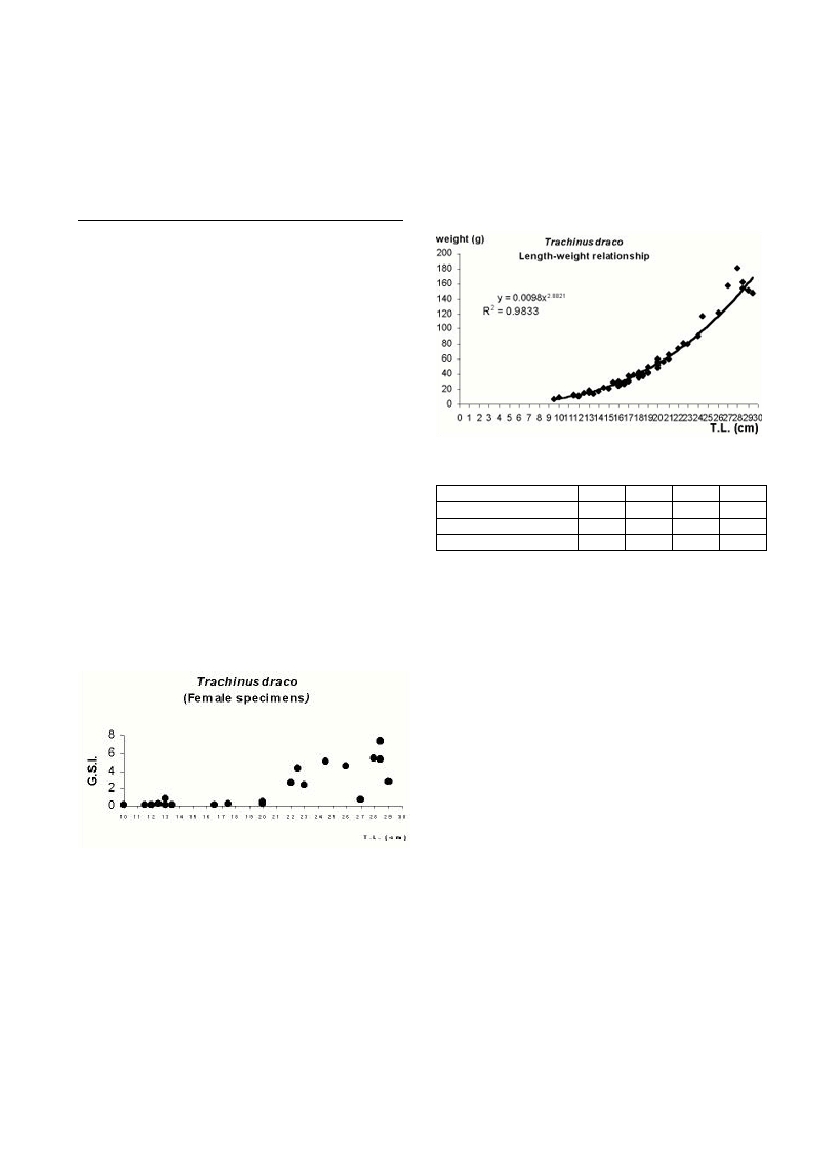Rapp. Comm. int. Mer Médit., 36,2001
298
Introduction
The greater weever (Trachinus draco L.) is widely distributed in the
eastern Atlantic from Norway to Morocco and it is very common in
the Mediterranean (1). In spite of this, scientific information on the
species is scanty or generic (2-5) and sometimes targeted to the venom
organs (6).
In the present paper, preliminary information on some biological
features (reproduction, growth) came from data collected in the south-
ern Adriatic Sea.
Materials and methods
Samples of T. dracocame from international trawl surveys (MED-
ITS Project, funded by E.U.) carried out from 1998 to 2000 in the
southern Adriatic basin (7) and from national trawl surveys (years
1998-2000) carried out in the western side of the same basin (Italian
waters) (8).
The collected specimens were measured by sex (total length, mm)
and macroscopic maturity stage was pointed out (9). Somatic weight
(g), as well as the weight of the female gonads was recorded also.
Otoliths (sagittae) were removed in order to age the specimens. Each
otolith was read at stereomicroscope by three different observers and
the coincident readings were accepted only.
Gonado-somatic indices (females), length-weight relationship and
length-at-age mean values were calculated.
Results
Greater weever was collected at 26-140 m depth range, and sixty-
three specimens were analysed in the 1998-2000 period. The survey’s
seasons corresponded to the referenced reproductive period in the
Mediterranean (4, 5), so macroscopic maturity stages and gonado-
somatic indices (% gonad weight/somatic weight) could be useful to
specify the length at maturity.With regard to male specimens, stage
four (ripe) of Nicolsky’s scale occurs at a minimum of 21 cm total
length, while females at the same stage were recorded at 20 cm total
length. Gonado-somatic indices (Fig. 1) confirm this last result.
Fig. 1 . Gono-somatics indices per length.
Length-weight relationship was computed on the whole sample
(Fig. 2), since no significant difference was found between sexes (par-
allelism test).
Otoliths readings were accepted for 56 specimens of the whole pop-
ulation, and length-at-age mean values of 13.9, 17.5, 18.7 and 22.4 cm
were estimated for age classes 1, 2, 3 and 4 respectively (Ta
b. 1). Due
to the low number, bigger individuals (TL>25 cm) were discharg
e
d
.
In view of the obtained results, individuals older than 3 years could
be considered potential spawners.
Fig. 2. Length-weight relationship (whole sample).
Tab. 1; Age-at-length mean values
Discussion and conclusion
The reported data adds information on the T. dracobiology in the
Mediterranean (at least for the southern Adriatic Sea), although it
needs improvements. In fact, the low number of analysed specimens
prevents the estimation of the maturity L50% or to fit a growth curve,
and we hope to make it the next future.
References
1.Whitehead P.J.P., Bauchot M.L., Hureau J., Nielsen J., Tortonese E.
(Eds.), 1986. Fishes of the North-eastern Atlantic and Mediterranean.
Unesco, Paris, vol. II : 1007 pp.
2.Bini G., 1968. Atlante dei pesci delle coste italiane. Mondo sommerso
ED., Roma, Vol V : 175 pp.
3.Tortonese E., 1975. Osteichthyes (Pesci Ossei). Fauna d'Italia, XI (2).
Edizione Calderini, Bologna : 636 pp.
4.FischerW., Bauchot M. L., Schneider M., 1987. Méditerranée et mer
Noire. Zone de pêche 37. Fiches FAO d'identification des espèces pour
les besoins de la pêche. Vertébrés. (Révision 1). Rome, FAO, 2 : 761-
1530.
5.Relini G., Bertrand J., Zamboni A. (Eds.), 1999. Sintesi delle
conoscenze sulle risorse da pesca dei fondi del Mediterraneo centrale
(Italia e Cosica). Biol. Mar. Med.6(suppl.1) : 443-445.
6.Skeie E., 1962. The venom organs of the Weeverfish (Trachinus
draco).Medd. Danm. Fisk. Havundersog. 3(10).
7.AA.VV., 2000. Medits Survey 1998/99 : Final Report. Project 97/25
Ifremer-CE, 97/13 IEO-CE, 97/69 SIBM-CE, 97/41 NCMR-CE.
8.AA.VV., 1999. Valutazione delle risorse demersali nell’Adriatico
meridionale dal promontorio del Gargano al Capo d’Otranto. Relazione
finale GRU.N.D. 2 (triennio 1996-1998). Ministero per le Politiche
Agricole. Roma.
9.Nikolsky G.V., 1963. The ecology of fishes. Academic press, London
and NewYork : 352 pp.
THE BIOLOGY OF THE GREATER WEEVER (TRACHINUS DRACO L., 1758 – OSTEICHTHYES,
TRACHINIDAE) IN THE SOUTHERN ADRIATIC SEA : A PRELIMINARY NOTE
Marano C.A
1
*., Martino M.
2
, Ungaro N.
1
1
Laboratorio Provinciale di Biologia Marina, Molo Pizzoli (Porto) - 70123 Bari, Italy - biologia.marina@teseo.it
2
Dip. Produzione Animale, Facoltà di Agraria, Università di Bari, Italy
Abstract
Preliminary information on some biological features of Trachinus dracoL. in the Southern Adriatic Sea are reported. Minimum lengths at
maturity of 21 and 20 cm were found for male and female specimens respectively. Length-at-age mean values of 13.9, 17.5, 18.7 and 22.4
cm were estimated for age classes 1, 2, 3 and 4 respectively.
Keywords : Teleostei, Reproduction, Growth, South Adriatic Sea.
age (year)
1234
mean length (cm)
13.9117.5318.7122.43
st. dev.
1.72.92.53.9
n° of specimens
1117217

